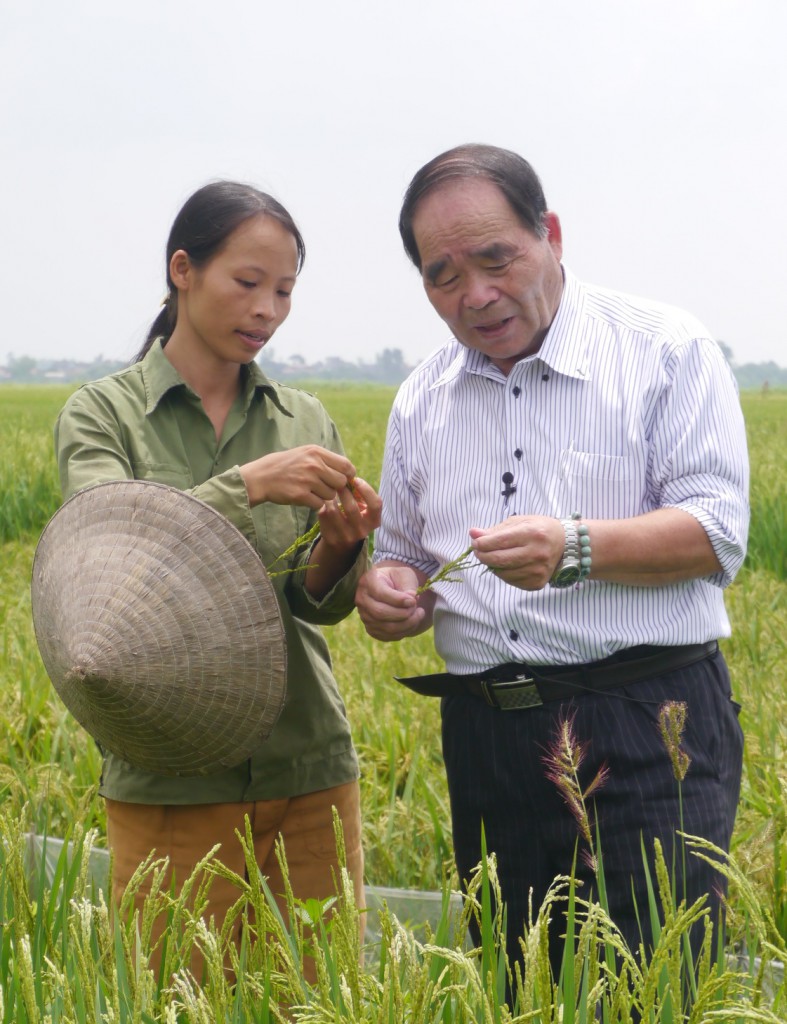
SEIBU KAIHATSU NOSAN Chairman Koichi Terui (right) instructs Phan Thi Hoa production of Hitomebore, a Japanese brand rice, in Binh Giang.
Kazuhiro Takamatsu – Binh Giang, Vietnam
In Vietnam, one of the member countries of the Trans-Pacific Partnership free-trade talks, Japanese firms are stepping up efforts to teach farmers ways to grow short-grain rice, or Japonica rice, for exporting. They are looking into future opportunities for Japan-bound exports, as they believe Japan will not be able to avoid lifting its tariff on rice amid increasing pressures from other TPP negotiators. If rice having the same quality as those grown in Japan is imported to Japan, domestic rice farmers could suffer even severer damage than the government estimates. The government should reconfirm the significance of protecting key agricultural products from tariff cuts.
An hour –and-a-half drive away from the capital city of Hanoi, in the city of Binh Giang in Hai Duong province, Akita-Komachi and Hitomebore rice plants sway in the paddies. Phan Thi Hoa, a 31-year-old farmer who grows them, says Japanese brand rice is easier to grow because their growth cycle is two weeks shorter than Vietnamese rice. Since farmers conduct triple-cropping in the region, they are currently nearing harvesting of the second crop.
SEIBU KAIHATSU NOSAN, an agricultural enterprise which cultivates some 600 hectares of rice and other crops in Kitakami, Iwate Prefecture, asked farmers in four areas near Hanoi, including Binh Giang, to grow Japanese rice on a trial basis to seek cultivation suited for the Vitenamese weather.
Some sterile plants were seen in the second crop due to high temperature and heavy rain combined, but SEIBU KAIHATSU NOSAN Chairman Koichi Terui, 68, says the firm hopes to systematize the cultivation method in Vietnam and start full-scale rice production next year. The firm plans to conclude contracts with local farmers by the help of the region’s major farms, and hopes to expand the cultivation area under contract to 1,000 hectares.
The firm also fosters instructors for farmers. Starting in September, the firm invited four Vietnamese to its headquarters in Iwate to teach them how to grow Japanese rice. It will also establish a subsidiary in Vietnam next year to purchase cultivated rice and sell them in Vietnam and other countries.
Terui explains that the firm decided to do business abroad because he believes the Japanese government will not be able to protect the five key agricultural products in the TPP negotiations. Considering that it would be difficult to survive by doing business only in Japan, the firm set on producing Japanese rice in Vietnam, which is a TPP member and where personnel cost is low. He says the rice will be exported for the time being to the United States and Malaysia, also TPP members, but that as a matter of course, he is considering exporting to Japan as a future possibility.
Arata Asanuma, new president of Tohoku Bank which supports Japanese agricultural enterprises start business overseas, says the agricultural industry should take measures to defend themselves from the TPP pact, adding that the bank hopes to make SEIBU KAIHATSU NOSAN’s business in Vietnam a model case for other farms to follow.
Angimex Kitoku, a Vietamese subsidiary of major rice wholesaler Kitoku Shinryo Co., also teaches the method of growing Japanese rice to a total of 1,000 local contract farmers annually and purchases cultivated rice for exports. The firm, which currently deals around 5,000 tons of rice annually, plans to establish a rice drying plant and increase the transaction volume to 10,000 tons in five years. Angimex Kitoku officials say the rice will be exported to countries such as Malaysia and Singapore which have demand for Japanese rice, adding that they are not necessarily focusing on exporting to Japan.
The Japanese government estimates that if a tariff on rice is abolished as a result of the TPP negotiations, 32 percent of rice grown in Japan will be replaced by rice produced in the U.S. and Australia, which are similar to Japanese-grown rice in quality. Although Vietnam is the world’s second largest exporter of rice with surplus export capacity, imports of Vietnamese rice is calculated as none in the government’s estimate, because the government judged that it is difficult to predict the scale or the pace of increase in Vietnam’s production of short-grain rice at this stage. If Vietnamese farmers manage to grow high-quality Japanese rice and start exporting them to Japan, its influence on Japanese rice production could become larger than the government estimate.
(Sept. 12, 2013)

